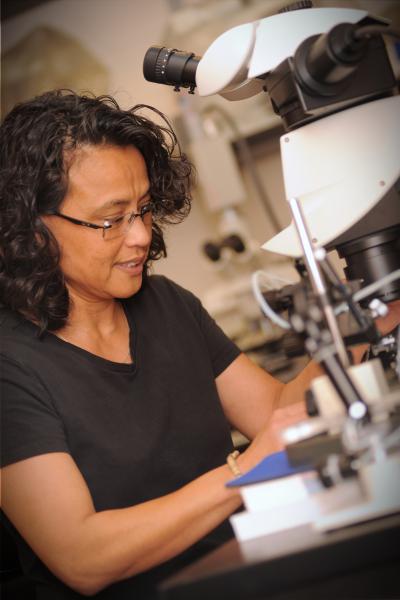Electric fish at NMSU activate stem cells for regeneration

New Mexico State University biologist Graciela Unguez and a team of researchers found that electric fish, a vertebrate animal just like humans, can regenerate their tails following amputation after activating their stem cells. The findings were published in the May 2012 edition of the scientific journal, PLOS One.
"What's surprising is that as humans, we're one of the few animal species that do not readily regenerate limbs, organs or most tissues," Unguez said. "So, there's a lot of interest in how these fish do it, and what's preventing us from doing it."
Regeneration is the process of restoring lost cells, tissues or organs. According to Unguez, most animals have the ability to regenerate eyes and tails and some animals may be able to regenerate up to half of their bodies.
The researchers discovered that when they cut off up to one third of an electric fish's tail, including the spinal cord, vertebrae, muscles, skin, connective tissues and nerves, the fish would regenerate it. Unguez said the more tissue cut off, the longer the regeneration takes, but for the purpose of her study, it takes about three weeks.
"It's really exciting to us because, here's an example of an animal that can regenerate a lot of tissue types that are also found in humans," Unguez said. "So it puts into question this previous idea that those animals that can regenerate losses of many tissues do it because they do it differently than humans."
Unguez has used the electric fish as a model system to investigate the role that the nervous system plays in the fate of electrically excitable cells like muscle cells for 15 years. She noted that for many years, scientists have thought that highly regenerative animals use a mechanism of regeneration that does not involve stem cells, and this stem cell-based mechanism is well known in humans. In contrast, the stem cell-independent mechanism found in highly regenerative animals is not normally active in humans.
Unguez explained that stem cells are a small population of cells that do not mature and stay with us throughout our life, and then when called upon, they reenter the cell cycle to become muscle cells, neurons, skill cells and such.
But, what Unguez and her collaborators discovered was the opposite. The electric fish actually activated its own muscle and electric organ stem cells to regenerate. She said the adult fish regenerated unendingly with the activation of their stem cells.
"It does not negate other mechanisms, but it definitely showed that it was largely due to an activation of stem cells, just like humans have," Unguez said. "So maybe it's not as far apart, maybe some of the mechanisms involved or the events that need to be activated are more closely related than we thought."
Regeneration was not Unguez's primary research interest when she began the project. The key focus in her lab is to conduct research on identifying the mechanisms responsible for the formation and maintenance of electrically excitable cells, like neurons and muscle cells. As a secondary interest, Unguez used regeneration to recruit students to her lab, because of their enthusiasm for the topic.
"I used it to try to lure their interest, learn some of the techniques in the lab, and then get them to answer some simple questions about my research program," Unguez said.
Unguez said is was that interest that led Christopher Weber, a former undergraduate student and first author of the paper, to drive the regeneration research. Weber is now a doctoral student at the University of Washington in Seattle.
"That was the impetus for me, to continue this research project," Unguez said. "He did a great job, and in two years, and in consultation with the other coauthors we basically said, 'OK, this is what needs to be done to really address this question about the mechanisms.'"
Collaborating on the project with Unguez and Weber were Mark Martindale, from the University of Hawaii; and Stephen Tapscot, at the Fred Hutchison Cancer Research Center in Seattle. Unguez credited Martindale as instrumental in generating data from experiments that further supported the involvement of stem cells as a key player in the regeneration of muscle and electric organ tissues of the tail. She has collaborated with Tapscot in the past on projects that study different aspects of muscle biology.
With the discovery of muscle stem cells over 40 years ago, Unguez said the field of regeneration will only continue to grow in the future.
"There is so much that we still don't know, Unguez said. "From processes like aging, to accidents, to disease, we are going to continue to lose tissue. It is a never-ending issue for all of us at any age, so there is a huge demand to try and solve that problem."
For more information, visit the Unguez lab at http://biology-web.nmsu.edu/unguez/index.html.


